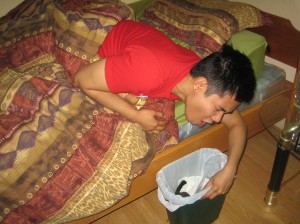Overview Of Poisoning
- Every year hundreds of individuals from all age groups need medical assistance for poisoning from products generally found in the home.
- These items include medicines, cleaning stuff, peroxide, swimming pool detergents, insecticides, cosmetics and fuel.
- 60 % of the victims of accidental poisoning are kids.
- Kids aged between 1 to 3 years are most at risk.
- Kids are curious, very mobile and like to place things in their mouths.
- The most widespread product that causes poisoning is paracetamol, which is a pain reliever found in almost every home.
Treatment and Symptoms For Poisoning
- Can be from eating, drinking or inhaling a particular poison
Every year hundreds of individuals from all age groups need medical assistance for poisoning from products generally found in the home - Poison touching the skin or being splashed in the eyes
- Stung or bitten by spiders, reptiles or marine animals.
Cases Involving Poisoning – Call EMS
If the casualty has passed out or has stopped breathing, do not wait; call the emergency services for an ambulance.
If a casualty is unaware but still breathing:
- Call the EMS for an ambulance.
- Put the casualty in the recovery position.
If the casualty is unaware but not breathing:
- Call the EMS right away for an ambulance.
- Begin CPR.
First Aid For Poisoning
Swallowed
If the casualty is aware:
- Do not encourage vomiting. Immediately rinse the mouth.
- Keep the container if the doctor needs to examine what the substance is.
On the skin
- Cautiously get rid of contaminated clothes.
- Clean the skin softly with soap and wash with running water.
Poison Splashing In the Eye
- Clean the eyes with a slow mild flow of water from a cup for about 15 minutes.
- Do not put any eye drops in the eye.
Inhaled
- Straight away get the casualty to fresh air, without putting yourself in danger.
- Undo any firm clothing surrounding the neck.
- Make sure you open any windows or doors, if you are inside the house.
- Keep away from breathing in any fumes. Do not attempt to save an unconscious casualty, where an extremely lethal or unidentified gas is concerned, without proper breathing gear. You might become a casualty yourself.
